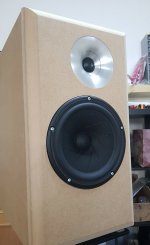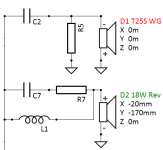As I had all the components around already, I was thinking of what to make out of it.
First I had to adjust the opening for the tweeter waveguide.
Prototype cabinets had 25l net volume, so I started with that.
Initial measurements proved the drivers were very linear so they would not be complex to make crossover for.
18W/4531G00 - perfect linear response, very consistent off axis responses, very good distortion (little bit higher H2 though). I added bucking magnet. Ideal for 3k low order crossover.
T25S in WG - generally these small Bliesmas don't like low crossovers and shallow slopes, so the target was at least 3k LR2. WG, though really small, works excellent. Top end is not as linear as in my prototype WG so I will still work on this. Combination of natural rolloff of waveguided response and and just simple crossover allowed 3k LR2 acoustic slope.
I was very pleased to see that this combo works excellent in Vituix even with the simple filters and that phase matching was good.
It has been 2wks since I started listening tests. In the meantime I lowerd internal volume to 22.5l MDF pieces and adjusted Tweeter level. Drivers also burned in so I could conduct some serious listening test to assess if this is worth completion.
So far I am very pleased with how this combo sounds. It is very natural, relaxed and easy to listen, though not too soft, muddy or slow in any way. Bass is great for smaller two way and midrange does not lack anything (this is generally an issue with any 6-7" in 2way when asked to do both bass and midrange right, so it was the reason I lowered the volume to ~22l after initial listening test, and bucking magnet also does its part in midrange improvement). The trebles have clarity (yes, clarity, though this adjective fits more to hard domes) and openess, with no hints of hiss or similar weaknesses normaly related to silk domes. I believe WG does its job well, controlled dispertion in ~3k-7k is always good things when effortless and clear trebles are the goal.
Overall this was very nice to see how all compenents fit together and resulted in great measured and listening results with just simple crossover.
First I had to adjust the opening for the tweeter waveguide.
Prototype cabinets had 25l net volume, so I started with that.
Initial measurements proved the drivers were very linear so they would not be complex to make crossover for.
18W/4531G00 - perfect linear response, very consistent off axis responses, very good distortion (little bit higher H2 though). I added bucking magnet. Ideal for 3k low order crossover.
T25S in WG - generally these small Bliesmas don't like low crossovers and shallow slopes, so the target was at least 3k LR2. WG, though really small, works excellent. Top end is not as linear as in my prototype WG so I will still work on this. Combination of natural rolloff of waveguided response and and just simple crossover allowed 3k LR2 acoustic slope.
I was very pleased to see that this combo works excellent in Vituix even with the simple filters and that phase matching was good.
It has been 2wks since I started listening tests. In the meantime I lowerd internal volume to 22.5l MDF pieces and adjusted Tweeter level. Drivers also burned in so I could conduct some serious listening test to assess if this is worth completion.
So far I am very pleased with how this combo sounds. It is very natural, relaxed and easy to listen, though not too soft, muddy or slow in any way. Bass is great for smaller two way and midrange does not lack anything (this is generally an issue with any 6-7" in 2way when asked to do both bass and midrange right, so it was the reason I lowered the volume to ~22l after initial listening test, and bucking magnet also does its part in midrange improvement). The trebles have clarity (yes, clarity, though this adjective fits more to hard domes) and openess, with no hints of hiss or similar weaknesses normaly related to silk domes. I believe WG does its job well, controlled dispertion in ~3k-7k is always good things when effortless and clear trebles are the goal.
Overall this was very nice to see how all compenents fit together and resulted in great measured and listening results with just simple crossover.
Attachments
Last edited:
I like the crossover, very elegant annd simple, apart from the resistor in the tweeter network. These units deserve a LCR there, I’d say.
markbakk: I did try LCR, and it did exactly the same effect as LCR + additional R in front of C to realize tweeter padding. See the topology in the attachment. The curves are overlaid.
The beauty of resistor in parallel to tweeter is that it does tweeter padding and also dampening of tweeter Fs impedance resonance at once. And the third benefit is no resistor in series path with tweeter. So in this case LCR does not bring anything extra compared to single parallel resistor.
The beauty of resistor in parallel to tweeter is that it does tweeter padding and also dampening of tweeter Fs impedance resonance at once. And the third benefit is no resistor in series path with tweeter. So in this case LCR does not bring anything extra compared to single parallel resistor.
Attachments
Interesting results for this combination of drivers and crossover topology.
It is good that it worked out so nicely.
It emphasises that until you build and measure your result there are no hard and fast guarantees for crossover design or complexity
Nice that you hit a sweet spot.
I guess if you were an internationally renowned manufacturer you could package this up in some wonderful sales blurb and have a niche product for some months before being knocked of the pedestal by the next new design.
It is good that it worked out so nicely.
It emphasises that until you build and measure your result there are no hard and fast guarantees for crossover design or complexity
Nice that you hit a sweet spot.
I guess if you were an internationally renowned manufacturer you could package this up in some wonderful sales blurb and have a niche product for some months before being knocked of the pedestal by the next new design.
Yes, that is the reason why I prototype so much. It is good to see what drivers do and how they sound before building final cabinets, particularly when I work with the driver for the first time. Phase relationships is what I am interested the most. I am not a friend of "let's fix everything with LR4 and RLCs" approach.




